7 Safer Smartwater Bottle Alternatives That Are Actually Practical for Thru-Hikers
Over the past few years, we’ve all been forced to slowly confront the fact that our Smartwater bottles — while the perfect size, weight, and rigidity for thru-hiking— are actively detrimental to our health.
Smartwater bottles are made from PET1 plastic, which is a food-safe plastic designed for single use. Repeated use, such as using the same bottle for days and weeks during a hike, causes the shed of nano and microplastics from your bottle.
The three most common water filters found among thru-hikers have pore sizes of 0.1 microns (Sawyer Squeeze and Katadyn BeFree) and 0.2 microns (Platypus Quickdraw). This means they will, in theory, filter out 100% of microplastics, which by definition are particles larger than 1 micron in diameter. However, they will still allow many nanoplastics (classified as any plastic shed under 1 micron) to pass through into your drinking water.
The three circumstances causing the largest shed of nanoplastics?
- Mechanical stress, such as the repeated squeezing of a bottle to filter water
- Heat exposure
- UV light exposure
I don’t know about you, but this sounds like the daily routine for my water bottle on a thru-hike.
How Bad Is it Really to Consume Microplastics?
The short answer is that we don’t know, but ongoing research suggests it’s not good. Several potential effects have been identified based on laboratory studies and emerging human health data including chronic inflammation, autoimmune conditions, and endocrine disruption.
Google Searches for “Microplastics” 2014 – 2024
Public interest in microplastics spiked in late 2022 and has been on the rise since. Research into the health impacts of microplastics is still ongoing.
I’m not a doctor and won’t fearmonger and speculate here as to the long-term health effects of microplastic consumption. However, it’s clear that reducing exposure where possible is a wise precaution.
Why Should I Care? Aren’t Microplastics in Everything?
This response, while understandable, is an appeal to futility aimed at shutting down a conversation still worth having. In so many aspects of life, our goals may not be fully achievable, but that does not mean there is no value in striving towards them anyways.
Think of it like washing your hands. You can’t eliminate every single germ, but washing your hands significantly reduces the number of harmful bacteria and lowers your risk of getting sick. Just because you can’t achieve total cleanliness doesn’t mean washing your hands is pointless — it still makes a meaningful difference. The same goes for reducing microplastic exposure. Even if you can’t avoid them entirely, minimizing exposure where you can still benefits your health.
And, over the course of an entire thru-hike, you’re ingesting a non-negligible amount of nano and microplastic.
I Hear You, but Smartwater Bottles Are Just Too Perfect!
I get this sentiment, I truly do. I’m picky when it comes to drinking water, and if the conditions aren’t perfect, I’ll simply allow myself to become incredibly dehydrated. Smartwater bottles, with their self-supporting rigidity, squeezable body, sport cap, and ultra-lightweight stats, are hard to beat. There’s just that tiny “slowly poisoning me” aspect of the bottle that makes it hard to feel happy carrying it.
Welcome to the battle of the bottles.
My Water Bottle Grading Criteria
I’m a simple girl. I have four things I’m looking for for in a water bottle for a thru-hike:
Lightweight and Right-Sized
I would love to say I’m one of those people who doesn’t care that much about weight, and would be willing to carry a heavy, metal bottle, but I’m not. Basically the only reason why I still carry Smartwater bottles with me is their miniscule weight and their ability to fit perfectly in the side pockets of my backpack. Whichever bottle comes out on top must either be incredibly light or have a feature or function that justifies the increased weight.
Self-supporting
I use my water filter to transfer water from a dirty bottle into a clean one that stands upright on the ground. Water reservoirs and bags don’t work for me because I need a bottle that can stand on its own, whether it’s full or empty, and be easy to drink from without collapsing.
Reusable/Chemically Stable Materials
For all their benefits, Smartwater bottles are simply not meant to be reused. I know we all care about sustainability and reducing our single-use plastic consumption, but reusing single-use plastic isn’t the environmental slam dunk some people seem to think it is. Single-use plastic will leach chemicals, microplastics, and harbor bacteria over time, especially when exposed to heat, UV light, or repeated mechanical stress. The best option is to find a bottle intended for reuse and stick with it for as long as possible.
Filter-Compatible/Squeezable
I need my water bottles to work with my filter or have an attachment that makes them compatible. One reason I don’t hike with a Nalgene is that I can’t squeeze it to push water through my filter. Being able to screw my filter to the top of my bottle and squeeze the bottle to filter water is almost non-negotiable for me.
Each of the following bottles will be judged on the criteria of weight, drinkability, materials, and filterability. May the best bottle win.
The Best Water Bottles for Thru-Hiking
Smartwater 1L Bottle
If you’ve clicked this article, you’re likely already familiar with the features of a Smartwater bottle. Still, I’ll give an overview:
Weighing only 1.2 oz, the Smartwater bottle is extremely lightweight and fits perfectly in standard backpack side pockets, making it a favorite for ounce-conscious thru-hikers. Its rigid structure allows it to stand upright on the ground, whether full or empty, providing a stable base for filtration and easy drinking. Is is made from PET1 plastic, which is designed for single use. The bottle is compatible with many popular water filters, including the Sawyer Squeeze, and is easy to squeeze for filtration.
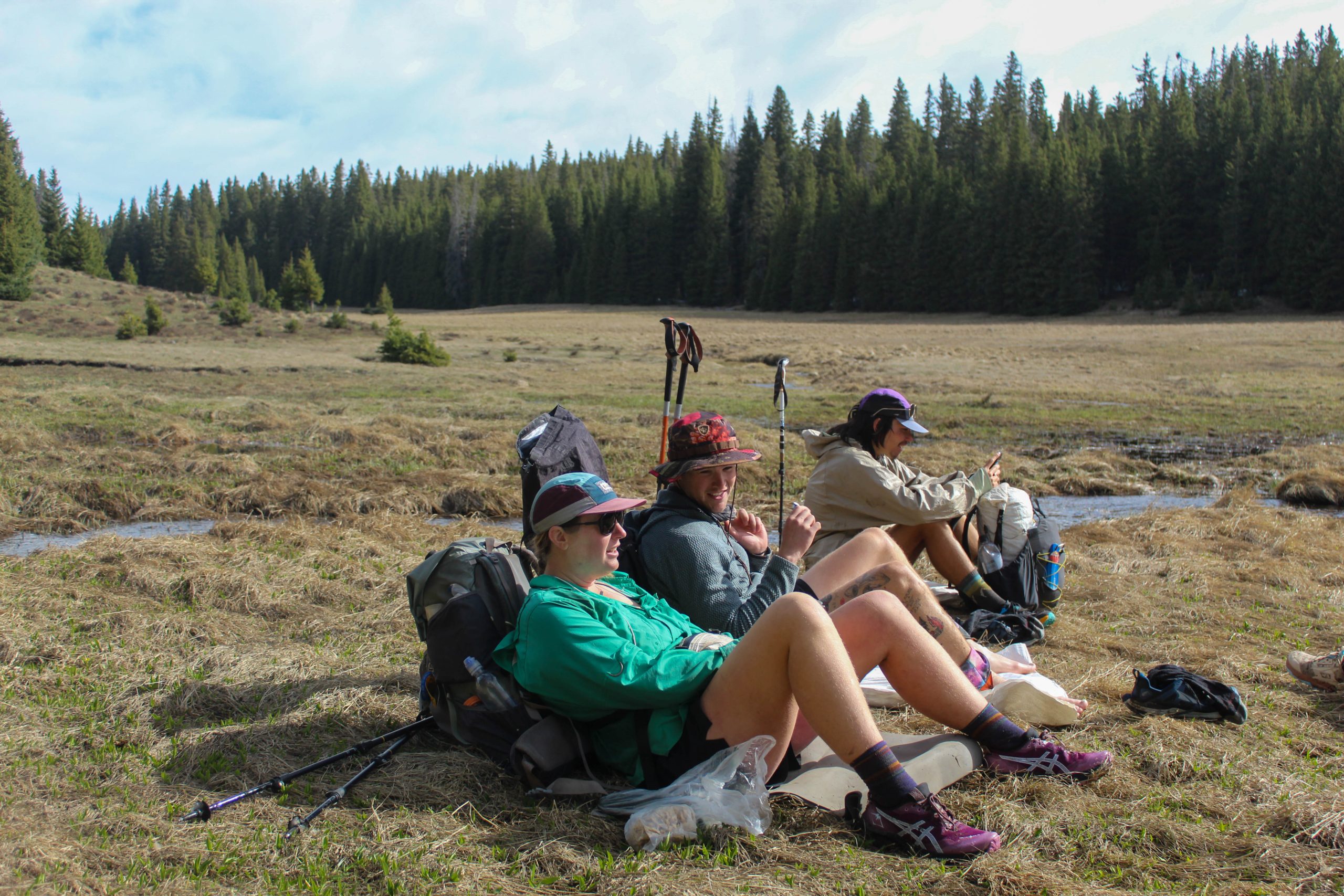
Lots of breaks are taken for thru-hikers to sit, chat, snack, and squeeze the contents of one Smartwater bottle into a second Smartwater bottle.
I give the Smartwater Bottle a 7/10. Contrary to what this article might suggest, I really don’t dislike the Smartwater bottle; it’s what I’ve carried on all my thru-hikes so far, and I’m really only willing to switch it up if I find something else equally as convenient.
What Sets It Apart: Generally, the Smartwater bottle is convenient for thru-hiking, as it’s cheap, strong enough to withstand the mechanical force for filtration, easily replaceable in most towns, and has a rigid, self-supporting body that still allows for squeezing.
Where It Falls Short: Smartwaters are composed of non-reusable plastic that sheds chemicals and nanoplastics into my water.
Squak Squaker Bottle
The Squaker Bottle feels like the child of a Nalgene and a Smartwater Bottle.
At 5.9 oz, it’s heavier than both the Smartwater bottle, but what sets the Squaker apart is its shape and construction materials. The bottle is made from Tritan plastic, the same material modern Nalgene bottles are made from. Tritan plastic is BPA free and incredibly durable. However, unlike a traditional Nalgene, the 32 fluid-ounce bottle matches the dimensions of a one-liter Smartwater, making packability and storage a breeze.
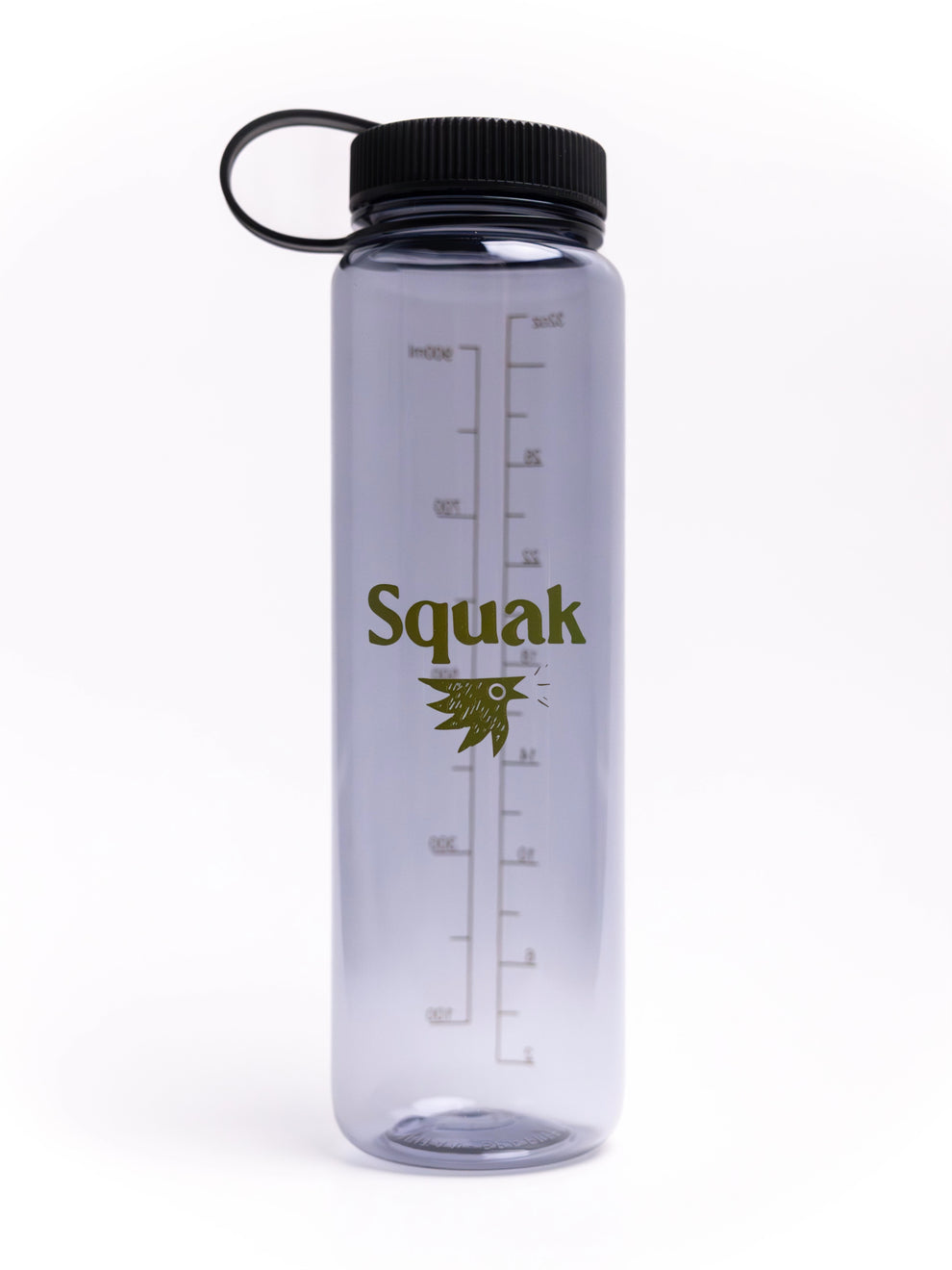
The Squaker is available on Squak’s website.
This bottle comes down to personal preference — how important is a sports cap to you? For me, I’m not a fan of the wide mouth, which is also why I’ve never entertained hiking with a Nalgene. Yet for Nalgene enthusiasts, this bottle is an absolute win. The Squaker gets a score of 6/10 for me, with the caveat that it probably sits at a 9.5/10 for Nalgene lovers.
What Sets It Apart: The durable and stable materials ensure that this bottle will last for decades, even through the demands of thru-hikes. The shape mimics a Smartwater Bottle, and you can still fit two comfortably in the side pocket of a pack.
Where It Falls Short: The wide mouth makes it hard to drink from while walking, the bottle is not compatible with any of the most popular water filters, and the bottle itself cannot be squeezed.
Ultralight Nalgene
At just 3.5 oz., the Ultralight Nalgene comes very close to the weight of the Smartwater Bottle while still being constructed with a stable and reusable polyethylene. For me, that’s about where the positives end.
The bulk and dimensions of the Nalgene don’t allow for two to fit together in a side pocket of a pack, the bottles aren’t compatible with any of the popular water filters, they can’t be squeezed, and the wide mouth makes it hard to drink from while walking.

Find the ultralight Nalgene at REI.
The Ultralight Nalgene gets a 3/10 on my scale because, if you were going to go for this, I would strongly recommend the Squaker Bottle instead. You can’t ever convince me that 2 oz. are worth the discrepancy in functionality over the course of an entire thru-hike.
What Sets It Apart: The bottle is quite inexpensive and lightweight.
Where It Falls Short: The dimensions of the Nalgene make it cumbersome and inconvenient to manage during a thru-hike.
HydraPak Flux
At 3.4 oz, the Flux is heavier than the Smartwater bottle but still relatively light for a reusable option. Its flexible design allows it to collapse for easy packing, and takes up less space when empty.
It has a rigid base, a feature lacking among many other silicone bottles which enables it to stand securely upright when full and mostly-securely when empty. Its biggest advantage over Smartwater is that it’s constructed from BPA-free TPU and silicone, making it suitable for long-term use without shedding microplastics or leaching harmful chemicals. Finally, it’s compatible with 42mm water filters (like the Katadyn BeFree) and can be squeezed.
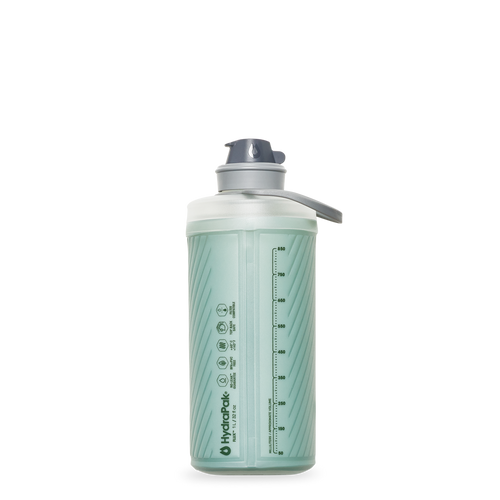
The HydraPak Flux is available at REI and comes in several colors.
I was as surprised as anyone by how much I loved this water bottle. It performs well in every category I care about and ends up dethroning the Smartwater bottle with a score of 9/10.
What Sets It Apart: The Flux packs down very small when empty, has a rigid body that supports the weight of the bottle while full and empty, comes with a sports cap mouthpiece, and is made from a stable, reusable material.
Where It Falls Short: The silicone body feels like it could break if squeezed incredibly hard. I worry that, at the end of my filter’s lifespan, it wouldn’t hold up to the absurd amount of force I’d put on it. I reached out to HydraPak and they assured me that all bottles come with a lifetime warrenty, but thru-hikers know how challenging it can be to coordinate mid-hike gear replacements.
CNOC Vessica
At 2.1 oz., the Vessica comes the closest to the weight of a Smartwater Bottle out of all the possibilities on this list. It compares most closely to the HydraPak Flux and, spoiler alert, I would almost always recommend the Flux over the Vessica.
The Vessica beats out Smartwater in the ways that all of the bottles on this list do: it’s made from FDA approved TPU, is BPA, BPU, and BPS free, and is designed for reuse. It also checks most of my boxes, like the ability to squeeze the bottle and its compatibility with popular water filters. Where it fails, however, is in its ability to securely support its own weight.
When I drink from the Vessica, I have to balance the bottle on my forearm to keep it from folding in half and sagging. It also doesn’t allow me to sit the bottle on the ground to refill it, since it isn’t self-supporting. One perk of the Vessica is the multiple cap size options — CNOC offers both a 28mm and a 42mm version to fit whichever water filter you currently use.
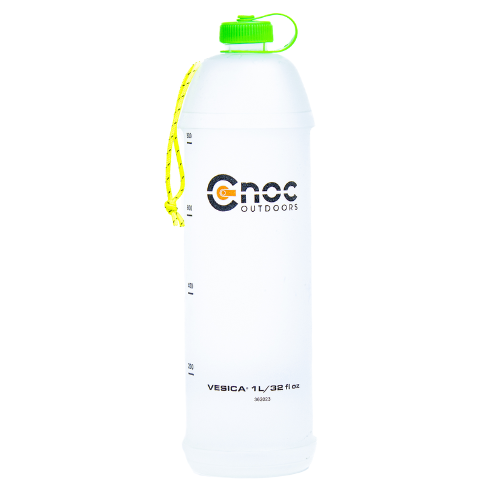
Find the Vessica at Garage Grown Gear.
I give the Vessica a score of 5/10; It addresses a lot of the features thru-hikers need from a water bottle, but the non-rigidity is enough of an issue to me that I find myself reaching for my Smartwater bottle over the Vessica.
What Sets It Apart: Cnoc has made versions of the Vessica that are compatible with both 28mm and 42mm filters.
Where It Falls Short: The floppiness and lack of support in the bottle makes it challenging to drink from and hard to set down when partially full or empty.
Drifter Lite Hydration System
The Drifter Lite Hydration System is hands-down one of the most innovative pieces of gear I’ve encountered in my time as a gear reviewer. Designed for versatility and reliability, this system redefines hydration on the trail. While the entire system does weigh in at 1lb, note that this weight includes 2.5 liters of water storage and an integrated filter. Even considering the weight penalty, I can still make a case for this replacing your Smartwater bottle.
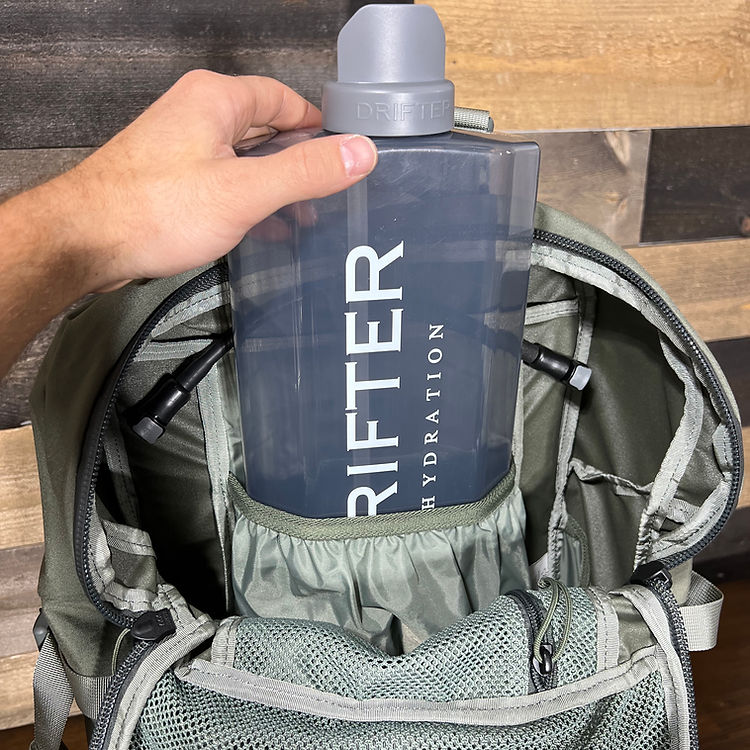
The Drifter Hydration kit is a great replacement for those frustrated with traditional soft-sided water bladders.
How It Works
The main setup consists of a 2.5L hard-sided reservoir, a pump bulb, a filter, and a straw/bite valve. Dirty water goes into the reservoir along with the filter, you squeeze the bulb to pressurize the interior, and open or bite on the valve to allow clean water to shoot out.
The entire system can also easily be turned into an inline or backfilling setup. My favorite part of this system are the endless, customizable uses. Thanks to the absurdly strong flow rate from the pressurization, the straw can be used for sipping, filling my pot, cleaning my spork, or filling another water bottle. While the setup comes with a filter from Drifter Hydration, the reservoir can also function with a Katadyn BeFree filter.
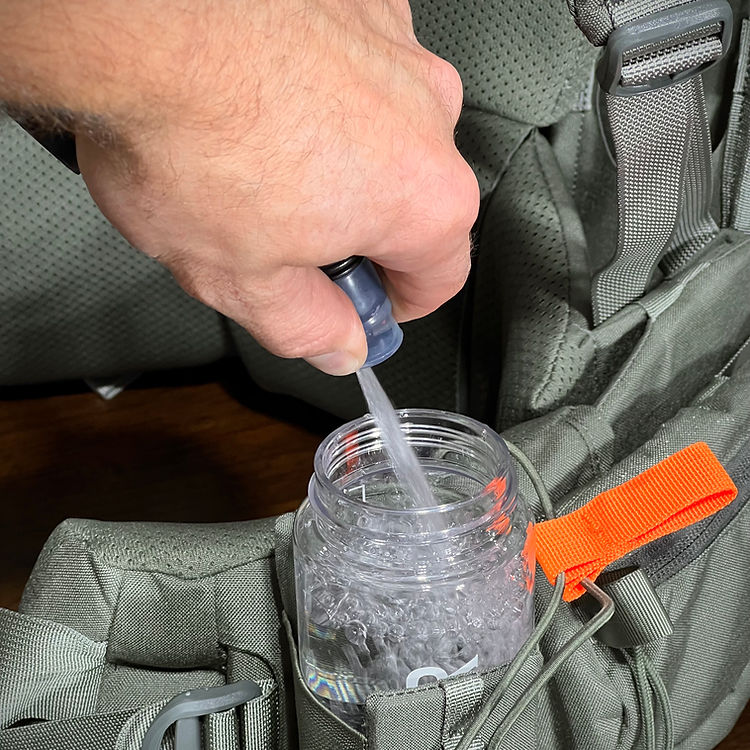
Find the Drifter Hydration system here.
The Score
I give the Drifter a score of 8/10. It’s the biggest change from a Smartwater bottle of all the options listed here, and takes some time to adjust to as a result, but the innovation and construction both blew my mind. I’m not sure this will be the system that comes on my next thru-hike (it is pretty heavy), but I would absolutely reach for this over a Smartwater bottle for 99% of my outdoor adventures. This will be my water system of choice for any day hikes, overnighters, ski tours, and camping trips.
What Sets It Apart: The pressurization allows you to get a good flow rate through a filter, even when the filter is old. It also removes the need to squeeze a bottle, and I am able to filter 2.5L of water faster than I can filter water from a 1L Smartwater bottle. It’s also perfect for people who like hiking with a reservoir but are frustrated by how easily those systems puncture and freeze.
Where It Falls Short: It’s heavy. I’m not trying to dance around that. But, as I mention in this article about lowering pack weight, the greatest weight-saver is being intentional with the amount of water you carry, not stressing over the weight of the bottle itself. The only person who can decide if the weight is a deal breaker is you!
Vargo BOT HD
The Vargo BOT HD is a multi-functional piece of gear that caters to hikers who love versatility. Constructed from titanium, it doubles as both a durable water bottle and a pot for cooking or cold soaking meals. With a wide-mouth opening, a watertight screw-on lid, a capacity of 1L, and a weight of 5.5oz., it’s designed to save space and weight by combining two essential trail items into one.
However, as much as I appreciate the BOT HD for its innovation and utility, I find it difficult to use as a dedicated water bottle. Once there’s even a hint of food residue inside, I don’t want to use it for drinking water. Additionally, if I’m using it to carry water, I lose the ability to use it as a cold-soaking jar, and vice versa. For those who prefer eating hot meals and enjoy cold soaking to reduce cooking time, this is a near-perfect solution. But for me, as a water bottle alone, it’s not functional. As a pot, the Vargo BOT HD gets a 10/10. As a water bottle, I give it a 2/10.
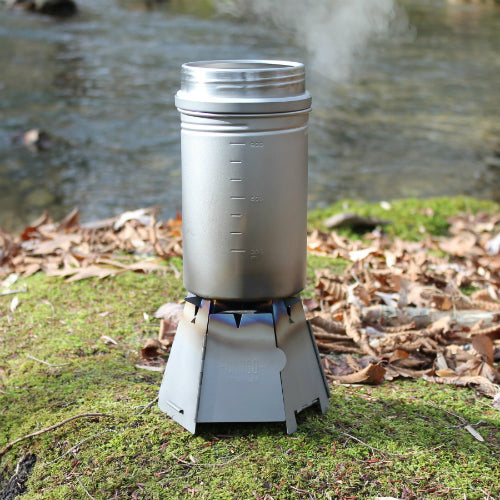
The Vargo BOT HD can also be found on Garage Grown Gear.
What Sets It Apart: The Vargo BOT HD excels as a multi-functional piece of gear for extreme ounce counters, doubling as both a 1L water bottle and a durable titanium pot for cooking or cold soaking.
Where It Falls Short: As a dedicated water bottle, it struggles with practicality. Food residue can make it unpleasant for drinking, and using it to carry water eliminates its functionality as a cooking pot. Its weight and cost are also significant downsides compared to simpler options.
Gatorade 32 oz Squeeze Bottle
Finally, we end this list with a bottle you likely recognize from your childhood. The Gatorade 32-ounce Squeeze bottle is an unexpected but effective choice for thru-hikers. Made from stable high-density polyethylene (HDPE), it’s lightweight, highly squeezable, and features a built-in sports cap for quick, one-handed hydration. At 1.7 oz, it’s the closest bottle on this list to the weight of the Smartwater bottle (just 0.5 oz heavier!).
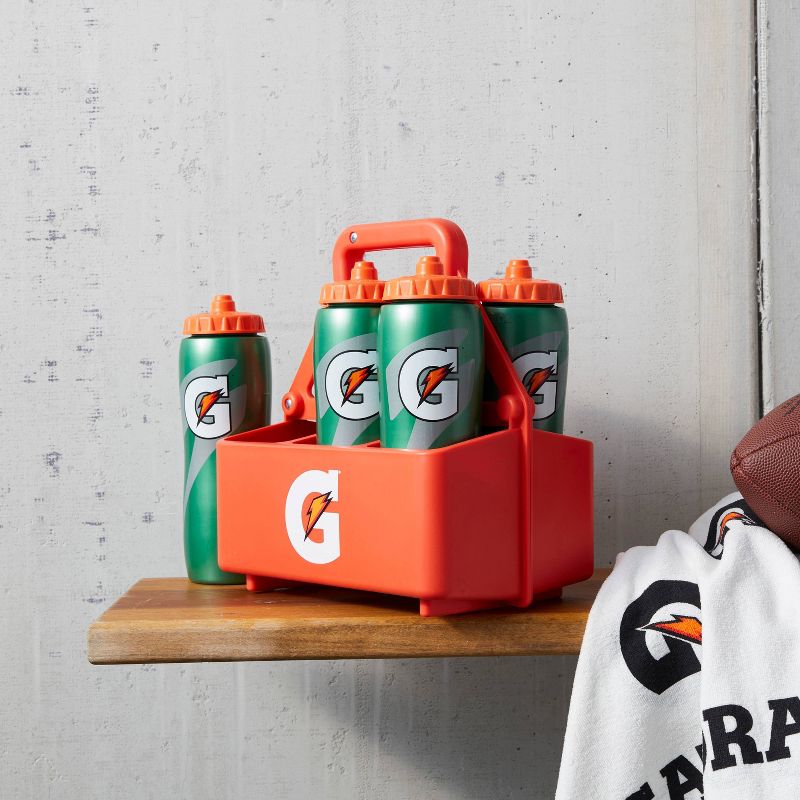
The Gatorade Squeeze bottles can be found at Target (or, likely anywhere with a sports aisle).
It also functions almost exactly like a Smartwater bottle while sharing similar dimensions. The big caveat? There is no filter compatibility with this bottle, and the cap is known to leak. I include this on the list as the best 1:1 replacement for a Smartwater bottle if you’re prioritizing cost, weight, features, and materials. This only works as long as you’re willing to use this as your clean water bottle and use a different bottle for dirty water.
I think enough other bottles on this list offer additional features that make them more functional than the Smartwater bottle and, therefore, more functional than the Gatorade Squeeze. I give the Gatorade bottle a 7.5/10. It’s better than a Smartwater bottle, but just barely.
What Sets It Apart: The Squeeze is lightweight, highly squeezable, and shares similar dimensions to the Smartwater bottle. Additionally, it’s made from stable HDPE for durability and safety.
Where It Falls Short: The bottle lacks filter compatibility, and the sports cap has a tendency to leak, making it less reliable for demanding thru-hike conditions. It works best as a clean water bottle but requires a secondary solution for dirty water handling.
The Water Bottle Roundup
| Bottle | Weight | Price | Score |
|---|---|---|---|
| Smartwater Bottle | 1.2 oz | $2 | 7 |
| HydraPak Flux | 3.4 oz | $27 | 9 |
| Squak Squaker | 5.9 oz | $15 | 6 |
| Ultralight Nalgene | 3.5 oz | $7 | 3 |
| CNOC Vessica | 2.1 oz | $18 | 5 |
| Drifter Hydration System | 1 lb | $85 | 8 |
| Vargo BOT HD | 5.5 oz | $110 | 2 (bottle), 10 (pot) |
| Gatorade Squeeze | 1.7 oz | $6 | 7.7 |
Ultimately, the right water system is the one that keeps you actively drinking water while on the trail. Only you can tell if a bottle’s non-rigidity or wide mouth will be a deterrent for your hydration. The good news? The variety of bottles and hydration systems available means there’s something for everyone. Whether you prioritize weight, durability, reusability, or compatibility with filters, there’s a solution to match your needs.
Did your favorite bottle make the list, or do you have another go-to hydration solution? Let me know in the comments — I’m always looking for other Smartwater bottle replacements!
The Flux, Squaker, Drifter Hydration System, and Vargo BOT HD were donated for purposes of review.
Featured image: Graphic design by Zack Goldmann.
This website contains affiliate links, which means The Trek may receive a percentage of any product or service you purchase using the links in the articles or advertisements. The buyer pays the same price as they would otherwise, and your purchase helps to support The Trek's ongoing goal to serve you quality backpacking advice and information. Thanks for your support!
To learn more, please visit the About This Site page.

 ">
">
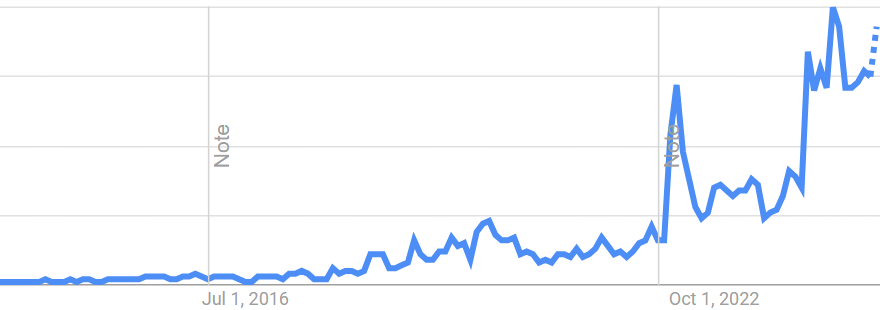
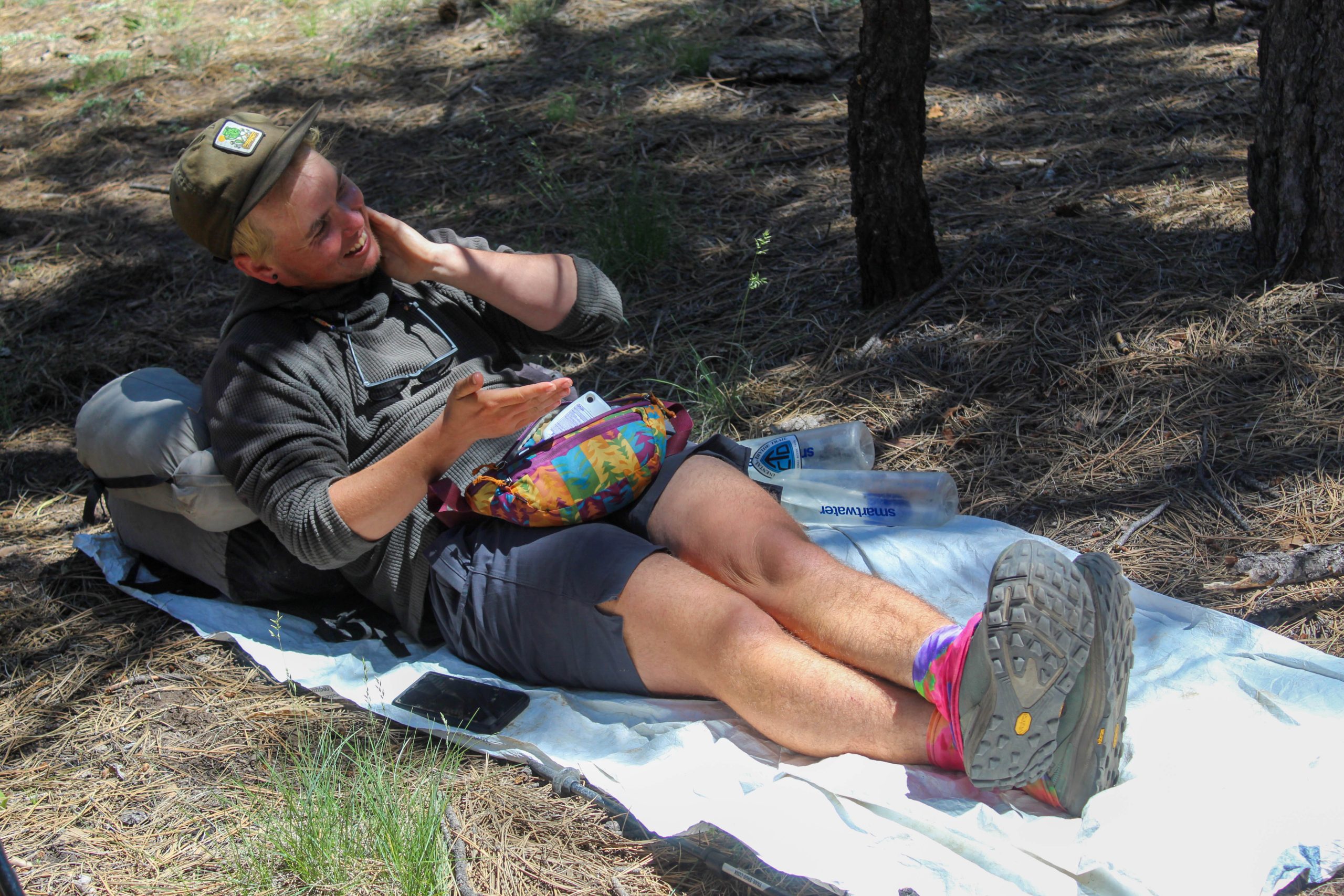


Comments 18
Not out yet, but the Mazama M!go bottles look pretty promising.
I’ve already pre-ordered mine and I’m STOKED!
I wonder if an adapter apparatus would work between a Nalgene and a water filter? Maybe with a squeeze reservoir?
I have a friend who has an adapter that gives a water bottle a hydration hose. I wonder if somehow that could be inline jerryrigged to pass through a filter? Maybe someone handier than I; I don’t mess around when it comes to water filtration haha
About a week ago CNOC announced a new option called the ThruBottle on their instagram. Has a SmartWater bottle profile and is releasing sometime this spring.
There’s also the Platypus SoftBottle. I gave it a try a little while back and it seemed decent but couldn’t figure out a way to attach it to my pack strap so I stopped using it.
I saw that! I was so bummed- all these companies released/announced exactly what I was looking for after I’d already gone through all the testing and written the article! I’ll definitely be trying out the Thru bottle.
Love this list! Something for everyone. I am sticking with the Ultralite Nalgene plus Vesica and Bot, because I love the wide mouth and mainly use the Vesica to carry water I’ll later consume from the Nalgene.
I didn’t find food residue to be an issue with the Bot, given that it’s so easy to shake it clean after dinner. But I did also carry a Talenti so that I could do cold breakfast and lunch while still keeping the Bot free for making coffee / carrying water.
I wonder if one of the baby bottle companies wouldn’t like to try to hack this for hikers. They are forced to be on the cutting edge.
Catch me hiking NOBO on some trail with my baby bottle this year.
I know so many people who love the wide mouth! I feel so crazy but a sport cap/nozzle is a MUST for me. Not that you need to be out there replacing things that work for you, but if you’re ever interested you should give the Squaker a try. Truly the love child of the UL Nalgene + Smart water bottle
Hmm.
I carry my water bottles in my shoulder strap pouches (Atom Pack)
I use a CNOX bag and Sawyer Squeeze
I use normal 509/750ml ‘soda’ bottles that I replace every two or three town stops with new ones. I drink the contents and use the bottles. It means I get clean bottles every so often and just use what I drink in towns. They are light, bountiful, recyclable and cheap (I’m buying the drink anyway)
I don’t care they do not screw into the sawyer, I just hold the bottle between my feet, balance the sawyer and squeeze. Never had an issue
Each to their own
That makes perfect sense! I think replacing soda bottles as you go is a really great solution to keep the material a little fresher. I usually hike on a pretty tight budget, so (even though its so cheap) I hate buying new bottles in town! A fun gear replacement that comes with a resupply treat!
I already use the CNOC Vecta as my dirty water bag; so, I thought I would give a look at the Vessica. However, many reviews refer to an unusual taste from the Vessica that lingers even after cleaning several times.
Back in the 70s when I started backpacking as a teenager, the “gold standard” for water bottles was the Sigg aluminum bottle. These are still available and weigh about 5oz.
I know I’m very picky when it comes to my water vehicle haha. I also am not a fan of a bottle where flavors linger, especially if I’m going to be using flavored powders.
I’ve been using the previous generation of the flux for a few years with the BeFree. I love it for the features described. It has held up well, though sprung a pin-hole leak. HydraPak was easy to work with to get a replacement, though I’m worried it will also leak at some point (definitely not a trip-ending failure though).
I’d never considered the Gatorade bottle – at that weight I will definitely give it a try!
Good article, thanks. And thank you for mentioning that nobody really knows if microplastics are bad for us. I’m a physician and though intuitively it seems like they would be bad there just isn’t conclusive repeatable evidence that they cause significant problems in the human body. But while thinking about it, I suppose that we must consider the plastics that our food is wrapped in, all of the plastics (big 3, clothing, pretty much everything) that we carry. Can’t imagine that a lot of typical trail food is good for us either.
Ultralight Nalgene also has a narrow mouth version. I prefer a rigid bottle with a narrow mouth, basically a safe version of a Smart Water bottle (love the narrow form factor), as I would use a bag to squeeze into a bottle from which I would drink. Does one of the newer bottles mentioned in the comments match this description?
1 liter Platypus softbottle with the hydration tube adapter cap and silicone tubing. Turn it cap side down in a side pocket, works great for me. Fill it up and never have to touch it again until you need a refill. Just push on the side pocket and you can feel if the water is low.
Thanks for writing this! I spent multiple hours searching the internet for reusable water bottles before my AT thru last summer. I started the trail with a Hydrapak Flux 1L and a Vesica, but when I hit MA, I got rid of my Flux and traded it for a 2nd Vesica. The Flux was plenty sturdy, but a lot of packs (looking at you, Dan Durston) build their side pockets specifically for smart water bottles, and the wide Flux was putting the squeeze on my Vesica. Side note, I’d definitely recommend against using a Vesica as a dirty water bottle – they’re not reputed to hold up well in a dishwasher, and they’re not easy to clean by hand either. I haven’t had the experience that others have had though around weird smells, my clean water Vesica held up pretty well.
Does anyone know if the Squaker Bottle has the same size opening as a standard Nalgene bottle? Thanks in advance!